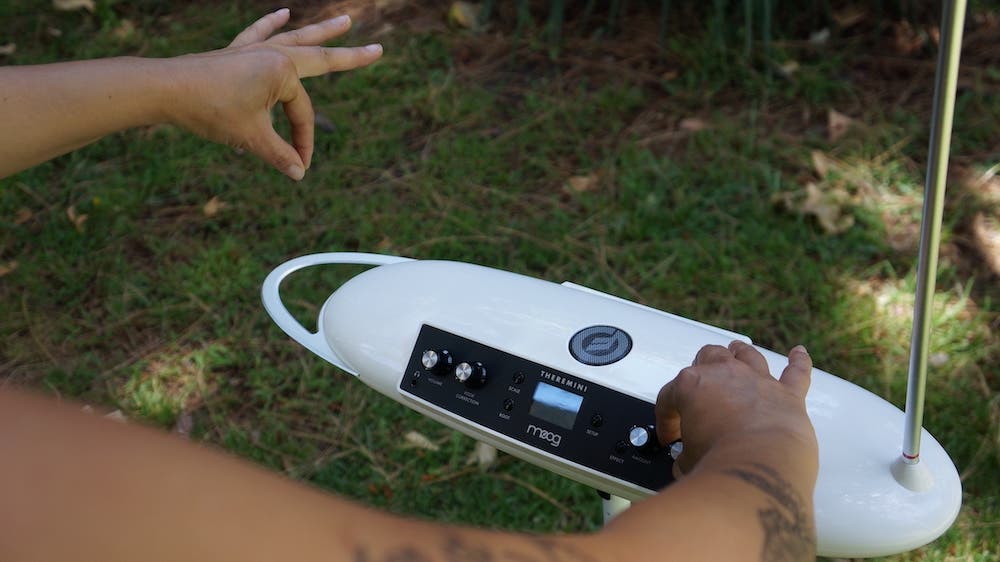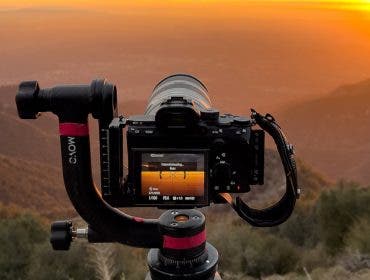The newest addition to the Theremin family — called the Moog Theremini — is the third of the series in the Moog family, joining the Etherwave and Etherwave Plus. This multi-faceted version of the Theremin is a reworking of one of the oldest electronic instruments in history, made famous by sci-fi soundtracks and popular electronic music genres.
The Theremin — named after its inventor Leon Theremin in 1929 — is an electronic instrument that does not require physical contact to play. That’s right. You play it by not touching it. In other words, you use body movement to control the pitch and volume of the instrument. Like the flagship models from the Etherwave series, the Theremini is a proximity-controlled synthesizer.
My First Impressions Using the Theremini
Upon opening the box of the Moog Theremini, you see a retro-futurist pod-shaped instrument. The interface, designed within a rectangular black control section, is minimal. There’s just four buttons, four knobs, and a backlit LCD screen. The four knobs adjust volume, pitch correction, presets, and effects. To start, unclip the antennae on the underside of the unit and insert it into the hole on top.
The Moog Theremini has four rubber feet for placement on a table. Although, it can easily attach to a microphone stand for a more flexible setup and extra elbow room. With the Theremini mounted to the mic stand, it is easy to place it anywhere in my studio with enough space on either side.
Given that Thereminis respond to the proximity of objects, the first thing to do when powering up is to run through the calibration procedure. You are guided through the process with clear instructions on the quick-start manual and the panel’s backlit LCD screen. Like anything new, getting used to the calibration process takes a few attempts before becoming intuitive. Finding video resources for quicker calibration techniques turned out to be invaluable. Once comfortable, the calibration process can be done in under two minutes.

How Does One Use the Theremini?
The Theremini’s sound is achieved by harnessing the electromagnetic fields. Proximity-related changes vary the capacitance in a pair of radio-frequency oscillators. In other words, your hands are manipulating invisible waves. Using the Theremini is simple in principle. Pitch and volume are the two main elements of playing the instrument. The pitch rises through a scale as your right hand approaches the vertical antenna. The volume attenuates as the left hand descends towards the looped antenna.
It’s all about hand gestures. To start, it’s as simple as choosing a synth preset and waving your fingers around the antennas. But it takes time to master the basics of coordination needed to play and articulate specific notes. Staccato notes are tough to make clean, but sweeping legato and soundscapes ring out naturally. The built-in tuner uses the LCD screen to display both the note being played and indicate whether the note is sharp, flat, or perfectly in tune. This is useful for correcting hand position and developing a musician’s ear to pitch and scale.
The other presets allow assistive pitch correction. This helps each player to adjust to the instrument’s level of playing difficulty. When activated, these presets will play every note in a selected scale perfectly. This makes it impossible to play a wrong note — a sort of “auto-tune” for air musicians. As the assistive pitch correction is decreased, more expressive control of pitch and vibrato becomes possible. When deactivated, there is no pitch correction.
The Moog Theremini has a small internal speaker so connecting the quarter-inch outputs is optional. it also has a front-loading mini headphone jack that is perfect for quiet practice. For live performance and gestural control, the rear panel of the Theremini features stereo line-level audio outputs, a pitch CV output with a selectable range, and a mini USB jack for MIDI connectivity to the free Theremini Mac/Windows software editor and Theremini iPad editor.

Who Would Benefit from the Theremini?
Compared to the original Theremin units, the Etherwave and Etherwave Plus, the Theremini is ideal for experimentation and more inviting to beginners. This instrument guarantees immediate access to anyone at any skill level. It also provides new ways to experiment with pitch training and music education. More advanced players can unlock new levels of technique and expression.
The Theremini has some initial sonic limitations, but it does pack in some useful features that extend its flexibility — such as the possibility of adding elements with the Moog Theremini Advanced Software Editor. This editor allows the Theremini’s synthesis engine to craft or re-sculpt existing presets and share them online. The Theremini editor also includes an exclusive library.
Overall, this is a fun and eccentric instrument that deserves your attention if you feel like escaping the limitations of pads, keyboards, or other midi controllers. The Theremini is an evocative and haunting instrument and stands right up there with the human voice and violin in terms of expression and beauty.






